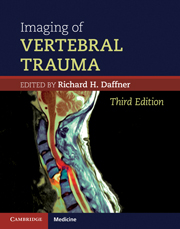Book contents
- Frontmatter
- Contents
- List of contributors
- Preface to the Third Edition
- Preface to the Second Edition
- Preface to the First Edition
- Acknowledgments
- 1 Overview of vertebral injuries
- 2 Anatomic considerations
- 3 Biomechanical considerations
- 4 Imaging of vertebral trauma I: indications and controversies
- 5 Imaging of vertebral trauma II: radiography, computed tomography, and myelography
- 6 Imaging of vertebral trauma III: magnetic resonance imaging
- 7 Mechanisms of injury and their “fingerprints”
- 8 Radiologic “footprints” of vertebral injury: the ABCS
- 9 Vertebral injuries in children
- 10 Vertebral stability and instability
- 11 Normal variants and pseudofractures
- Index
5 - Imaging of vertebral trauma II: radiography, computed tomography, and myelography
Published online by Cambridge University Press: 21 April 2011
- Frontmatter
- Contents
- List of contributors
- Preface to the Third Edition
- Preface to the Second Edition
- Preface to the First Edition
- Acknowledgments
- 1 Overview of vertebral injuries
- 2 Anatomic considerations
- 3 Biomechanical considerations
- 4 Imaging of vertebral trauma I: indications and controversies
- 5 Imaging of vertebral trauma II: radiography, computed tomography, and myelography
- 6 Imaging of vertebral trauma III: magnetic resonance imaging
- 7 Mechanisms of injury and their “fingerprints”
- 8 Radiologic “footprints” of vertebral injury: the ABCS
- 9 Vertebral injuries in children
- 10 Vertebral stability and instability
- 11 Normal variants and pseudofractures
- Index
Summary
The previous chapter discussed the indications for imaging patients with suspected vertebral injuries. This chapter discusses the three imaging modalities that use ionizing radiation: radiography, CT, and myelography. These techniques are frequently used in combination to arrive at the correct diagnosis. This chapter reviews each of these imaging formats and illustrates their uses in the diagnosis of vertebral injury. Chapter 6 will discuss MR imaging. Chapters 7 and 8 describe the integrated use of multiple imaging techniques.
Radiography
Radiography was the foundation on which the diagnosis of vertebral injury was made [1,2]. As Chapter 4 illustrated, in an era when specialized imaging techniques such as CT and MR are commonplace, radiography has taken a “back seat.” In the past, radiography was used extensively and relied upon to screen the patient and to make an initial diagnosis. Special imaging techniques were then used to confirm the initial impression and to outline the extent of damage. However, despite the advantages of CT, in many instances it is still necessary to refer to radiographs for guidance, particularly for operative planning. Furthermore, there are still many places in the world where CT is not readily available on an emergency basis and trauma physicians still must utilize radiography. For this reason we include radiography in this discussion.
Techniques
What is the “routine” series of radiographs for examining an adult with an acute vertebral injury? This question is frequently asked of radiologists by their surgical colleagues.
- Type
- Chapter
- Information
- Imaging of Vertebral Trauma , pp. 53 - 71Publisher: Cambridge University PressPrint publication year: 2011



